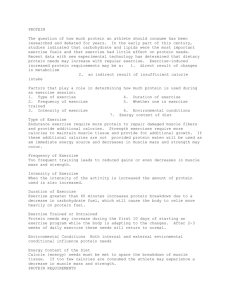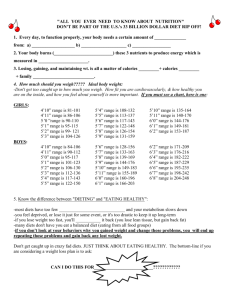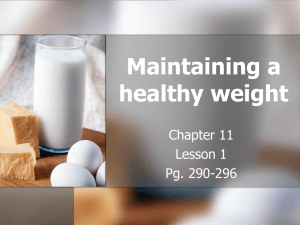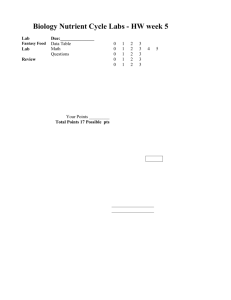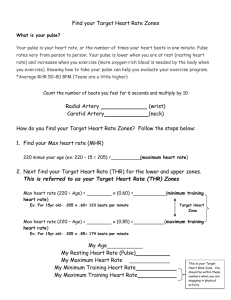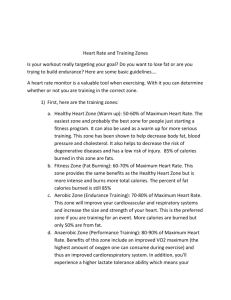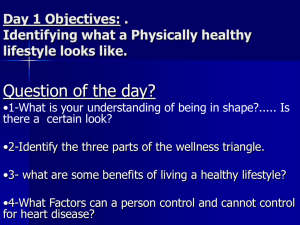On average, women gain about 30 pounds during pregnancy, 18 to
advertisement
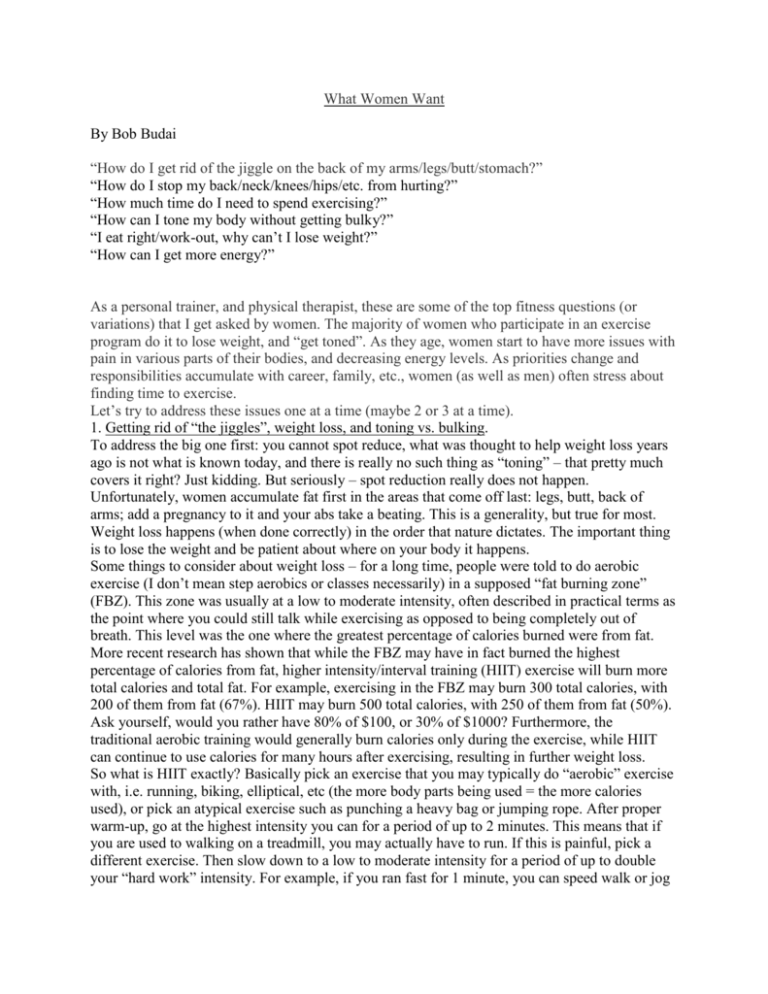
What Women Want By Bob Budai “How do I get rid of the jiggle on the back of my arms/legs/butt/stomach?” “How do I stop my back/neck/knees/hips/etc. from hurting?” “How much time do I need to spend exercising?” “How can I tone my body without getting bulky?” “I eat right/work-out, why can’t I lose weight?” “How can I get more energy?” As a personal trainer, and physical therapist, these are some of the top fitness questions (or variations) that I get asked by women. The majority of women who participate in an exercise program do it to lose weight, and “get toned”. As they age, women start to have more issues with pain in various parts of their bodies, and decreasing energy levels. As priorities change and responsibilities accumulate with career, family, etc., women (as well as men) often stress about finding time to exercise. Let’s try to address these issues one at a time (maybe 2 or 3 at a time). 1. Getting rid of “the jiggles”, weight loss, and toning vs. bulking. To address the big one first: you cannot spot reduce, what was thought to help weight loss years ago is not what is known today, and there is really no such thing as “toning” – that pretty much covers it right? Just kidding. But seriously – spot reduction really does not happen. Unfortunately, women accumulate fat first in the areas that come off last: legs, butt, back of arms; add a pregnancy to it and your abs take a beating. This is a generality, but true for most. Weight loss happens (when done correctly) in the order that nature dictates. The important thing is to lose the weight and be patient about where on your body it happens. Some things to consider about weight loss – for a long time, people were told to do aerobic exercise (I don’t mean step aerobics or classes necessarily) in a supposed “fat burning zone” (FBZ). This zone was usually at a low to moderate intensity, often described in practical terms as the point where you could still talk while exercising as opposed to being completely out of breath. This level was the one where the greatest percentage of calories burned were from fat. More recent research has shown that while the FBZ may have in fact burned the highest percentage of calories from fat, higher intensity/interval training (HIIT) exercise will burn more total calories and total fat. For example, exercising in the FBZ may burn 300 total calories, with 200 of them from fat (67%). HIIT may burn 500 total calories, with 250 of them from fat (50%). Ask yourself, would you rather have 80% of $100, or 30% of $1000? Furthermore, the traditional aerobic training would generally burn calories only during the exercise, while HIIT can continue to use calories for many hours after exercising, resulting in further weight loss. So what is HIIT exactly? Basically pick an exercise that you may typically do “aerobic” exercise with, i.e. running, biking, elliptical, etc (the more body parts being used = the more calories used), or pick an atypical exercise such as punching a heavy bag or jumping rope. After proper warm-up, go at the highest intensity you can for a period of up to 2 minutes. This means that if you are used to walking on a treadmill, you may actually have to run. If this is painful, pick a different exercise. Then slow down to a low to moderate intensity for a period of up to double your “hard work” intensity. For example, if you ran fast for 1 minute, you can speed walk or jog for up to 2 minutes. Then repeat this cycle for however long you had planned to exercise, or whatever you can accomplish. Realize that even if you cannot last as long as you do with the typical aerobic exercise, if the intensity is high enough, you will still burn more calories. Don’t take what I am saying wrong, people can and will lose weight with the typical aerobic exercise. The high intensity workout is another option for those who have not benefited or cannot participate in the typical workout program. The other piece of the weight loss puzzle that many miss, is the resistance training component. Strength training is necessary for many health issues, including weight loss. Metabolism, or how many calories your body uses for various activities, as well as doing nothing at all, is directly related to how much muscle you have. It takes 50 calories/day to maintain 1 lb. of muscle. This equates to 350 calories per week and 18,200 calories per year. About 3500 calories equal 1 lb., so 18,200 calories burned is a little over 5 lbs. lost by doing absolutely nothing beyond maintaining the muscles you already have. Add 5 lbs. of muscle and your body will burn about 25 lbs per year just maintaining that muscle. The other benefit of strength training is to add muscle to those areas that “jiggle”. While you will not necessarily burn the fat by adding muscle there, having muscle in those areas as opposed to not having muscle there is still a better option. You will also help achieve the “toned” look. Let me break down the whole issue of “toning. A muscle can either grow, shrink, or stay the same. To build muscle for tone versus bulk means to grow the muscle less, either way you need to resistance train. If women don’t take steroids, become crazy gym rats, make big muscles a priority, or have genetically large muscles; and if they mix it up with the cardio/interval exercise, they generally will not get too bulky. To build muscle, the exercise needs to be somewhat intense. Many people waste time in the gym doing an exercise with far too light of a weight. If you are doing 3 sets of 10 reps (another story all together) with a weight that you could do 3 sets of 50 reps with, then you should use a heavier weight or do more reps. Make each set a challenge, if the weight is too light do more of them and then go heavier next time. You body does not know the convenience of the number 10 or 20. If you do 11 or 17 reps, nothing bad will happen, maybe something good will though. Most people who work out for 1 hour or more could be done in half that time or less if their workouts were intense enough and they got down to business. 2. Stop the pain Pain can happen anywhere, to anyone. As we age, pain often becomes more prevalent due partly to normal changes that occur in our bodies, but also due to the lack of exercise or physical activity that we used to do. According the American Obesity Association, 62% of women, ages 20 to 74, are overweight (Body Mass Index (BMI) of 25 or more) and about half of that population (34 percent) is obese (BMI of 30 or more). As far as back and neck pain, studies have shown that for every 1 lb. of weight carried in front of a person (stomach, chest, etc.) about 10 lbs. of stress is put on the spine; not to mention the hips, knees, and ankles/feet. How do we stop this? One, either don’t gain weight or take off the weight that you can (see the above section). Two, strength train to help support the extra 10 lbs. (or more) that is on your joints. On an additional note, WebMD examined five medical conditions that are of great concern to women: heart disease, breast cancer, osteoporosis, depression, and autoimmune diseases. The list of risk factors for these conditions included many things that cannot be changed (age, sex, race, etc), but common between the first 3 were high blood pressure, physical inactivity/sedentary lifestyle, and obesity/overweight – all of which can be helped with exercise. Depression and autoimmune disorders also have plenty of research to show the value of exercise for treatment. 3. How much time? The most precious commodity for many of us, these days we need 48 hours in 1 day to get everything done. Our personal needs take a back seat to many other things. This holds especially true for women. Things are different than they used to be. Many women have full time careers and families to take care of. Not to say that we men don’t work hard. But I can say that with as much as I may do, I am amazed at how my wife can balance her career with taking two kids to and from day care, coming home and making dinner, cleaning up, packing lunches, etc. – all before I get home from work (I do help out). For many women they only have maybe 10-20 minutes to work out, or maybe that is all the time they want to devote to it with their other priorities. The good news is, if you have 10-20 minutes, that is great. As I said before, most people waste a lot of time working out. If you are there to be social, that’s fine too, but don’t mistake that social time as workout time. The high intensity/interval training I spoke of earlier generally does not last longer than 10-20 minutes initially, if even that long. Alternate that with strength training days (still 10 – 20 minutes of intense work) and you can have an awesome workout. 4. Where is my energy? It’s pretty simple, your energy probably has gone to the job, children, spouse, home, etc. and as was just stated – not to you. Proper exercise and diet (not the quick fast food dinner that may be common) has to become a priority again. A little activity goes a long way. One of the best exercises a person can do if they have young children, is do what the kids do and join them in their playing. Rather than trying to have kids calm down because we are too tired, let them go all out (not on the Playstation, I’m talking good old active playtime) and join them. You will find that it can be very intense exercise, and if you can work up to playing the whole time they do, your overall energy levels will get up there as well. If playing with kids in not an option, and besides working out as I just described, take other steps like parking farther away from the door at work, the mall, etc. and walk. Use the stairs vs. the elevator. Do some stretching during your lunch break. Find an excuse to be active, and do not forget the importance of eating right and getting enough sleep (about 8 hours for most adults). Realize that “intense exercise” is very relative. What is intense for one person is easy for the next. Only you know how hard you are working, but actually work when you work-out. Always warm-up, pick some exercises you like (or at least don’t hate for a few minutes) and go for it. You will improve over time if you give it a chance. Ask an expert if you are unsure of proper technique, use of equipment, etc. Just about anything is better that nothing as long as it does not cause pain or other undesirable effects. Be like Nike – “just do it”. And in regards to the title of this article, besides the fitness part, I’m still trying to figure it out. Bob can be reached for questions at bob@functional-strength-training.com
